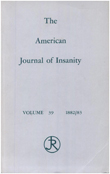Multicenter clinicopathological correlation in dementia
Abstract
OBJECTIVE: The aim of the present study was to determine the accuracy of clinical diagnoses of dementia in a large group of patients evaluated in a multicenter, university-based, Alzheimer's disease diagnostic and treatment program. METHOD: Clinical diagnoses and neuropathological results from seven collaborating Alzheimer's disease research centers were compared for 196 cases of dementia. RESULTS: When diagnoses of probable Alzheimer's disease, possible Alzheimer's disease, and Alzheimer's disease plus another condition were combined, 163 (83%) of the patients were clinically regarded as likely to have had Alzheimer's disease. Of those patients, 134 (82%) were found to have neuropathological changes diagnostic of Alzheimer's disease or Alzheimer's disease plus another condition. A total of 116 patients were diagnosed as having probable Alzheimer's disease; 100 (86%) of those were found to have pathological diagnoses of Alzheimer's disease or Alzheimer's disease plus another condition. Cerebral infarcts were found in 17% of the patients clinically diagnosed with probable Alzheimer's disease. Lewy bodies with variable Alzheimer's disease-type pathological changes were found in 7% of the patients with clinical diagnoses of probable Alzheimer's disease. Conversely, significant Alzheimer's disease-type pathological changes were found in 55% of the patients clinically diagnosed as having vascular dementia. CONCLUSIONS: Clinicians accurately predict Alzheimer's disease-type neuropathological findings in a high proportion of cases of dementia but may not predict cerebrovascular pathology and Lewy bodies in some patients with apparent clinical Alzheimer's disease and may often fail to predict Alzheimer's disease-type pathological findings in patients with apparent vascular dementia. With the emergence of effective treatments for Alzheimer's disease, there is an increasing need to optimize methods for ante-mortem diagnosis of dementia.
Access content
To read the fulltext, please use one of the options below to sign in or purchase access.- Personal login
- Institutional Login
- Sign in via OpenAthens
- Register for access
-
Please login/register if you wish to pair your device and check access availability.
Not a subscriber?
PsychiatryOnline subscription options offer access to the DSM-5 library, books, journals, CME, and patient resources. This all-in-one virtual library provides psychiatrists and mental health professionals with key resources for diagnosis, treatment, research, and professional development.
Need more help? PsychiatryOnline Customer Service may be reached by emailing [email protected] or by calling 800-368-5777 (in the U.S.) or 703-907-7322 (outside the U.S.).



